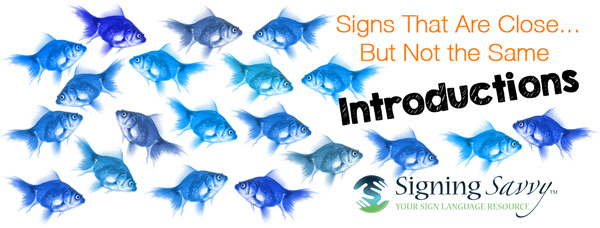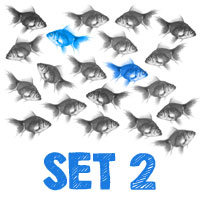
Signs That Are Close... But Not the Same — Introductions
This article is part of our “Signs That Are Close... But Not the Same” series, which highlights signs that look similar, but have different meanings.
The ASL signs shown below look similar, but are not the same. There are many ASL signs that when produced look similar, but in fact have a completely different meaning. Below you will find examples of such signs. Watch closely to see if you can see the differences. In addition, watch my eyebrows, look to see when I tilt my head or lean my body in a certain way, even what my mouth is doing. These nuances are called inflections and trust me, inflections matter.
These examples are all signs you may learn when first beginning to sign and are often used as common vocabulary when doing introductions.
1. Name vs. Weight
NAME and WEIGHT look similar, but you will notice the movement used is different across these two signs. It is an important difference you will want to sign correctly because when you are first meeting someone you want to say, “My name is…” and not, “My weight is…”
- When signing NAME both hands are in the H handshape with the dominant palm facing the center with the top two fingers (index and middle fingers) resting on top of the fingers of the non-dominant palm facing the body. The dominant hand taps on top of the non-dominant hand two times. Think of forming an X with your fingers as you form the sign and the X represents the place where a name is placed when writing a signature.
- When signing WEIGHT both hands are in the H handshape with the dominant palm facing the center with the top two fingers (index and middle fingers) resting on top of the fingers of the non-dominant palm facing the body. The dominant hand makes a downward dipping motion. Think of the weight on a scale.
 |
2. I vs. You
Both of these signs use the index finger to point at the subject. Although they use the same handshape and movement, it is easy to tell the difference between them because we commonly use these hand movements when speaking. Point at yourself when signing I and point at the person you are talking about when signing YOU.
 |
3. You (also He and Her) vs. Your (also His and Hers)
Here’s where we get a little tricky with new signers and they quickly learn the importance of handshape and how using a different handshape will change the meaning of a sign. With both signs, you point toward your subject. Use the index finger to point when signing YOU and use the open B handshape when signing YOUR. Remember the sign for YOUR by thinking of pushing something toward someone to show that it is “yours” or belongs to them.
The sign for YOU is also used to sign HE and it is used to sign HER.
The sign for YOUR is also used to sign HIS and it is used to sign HERS.
 |
4. Your vs. My
Now, if you can remember to use the open B handshape when signing both of these signs, you will be all set. The movement and directionality of these signs is the easy part to remember. As mentioned above, you can remember the sign for YOUR by thinking of pushing something toward someone to show that it is “yours” or belongs to them. You can remember MY by thinking of something you hold close to yourself.
 |
5. My (also Mine) vs. I (also Me)
Similar to the differences between YOU or YOUR, the important difference between these two signs is the handshape. Both signs point toward your body. I uses the index finger and MY uses the open B hand.
The sign for I is also used to sign ME.
The sign for MY is also used to sign MINE.
 |
6. Deaf vs. Dorm vs. Home vs. Native American
These signs are all very similar with the exception of the handshape used. They all start with the dominant hand, palm facing the body, tapping the side of the mouth, and then moving back to touch close by the ear.
- DEAF uses the 1 handshape.
- DORM uses the D handshape.
- HOME uses the flat O handshape.
- NATIVE AMERICAN uses the F handshape.
 |
||
7. Good vs. Bad
Just like MY and YOUR, with both of these signs, the dominant hand is in the open B handshape. The dominant hand, with the palm facing up, starts near the chin and and moves down into the palm of the non-dominant hand. The dominant hand moves straight down when signing GOOD, while it flips over and lands palm down into the non-dominant hand when signing BAD.
You can remember these signs by thinking of bowing down to show appreciation and thanks when signing GOOD and thinking of slapping down something bad when signing BAD.
 |
8. No vs. 20 vs. Duck vs. Chicken
These signs look similar because they have the palm facing forward, use similar handshapes, and similar movements.
Handshapes: NO and DUCK both use the bent 3 handshape in an opening and closing motion, while TWENTY and CHICKEN both use the L handshape, or index finger and thumb, in an opening and closing motion.
Positions: NO and TWENTY are in front of the body, while DUCK and CHICKEN are by the mouth.
You can remember DUCK and CHICKEN are by the mouth because their signs are like beaks. The handshape used for DUCK is wider than the handshape used for CHICKEN, just like the beak of a DUCK is wider than the beak of a CHICKEN.
Think of NO as signing a combination of the letters N and O. When signing TWENTY think of how the use of 2 fingers shows the number 2 in 20, and closing them shows the 0. TWENTY is signed in front of the body, like the rest of the numbers.
 |
||
9. Meet (as in “I met”) vs. Meet (as in “meet me”) vs. Meet (as in “they met”) vs. MEET (as in, "to meet many people")
MEET is signed using a directional sign. Directional signs are signs that describe both the action and who performed the action. By changing the directionality of the sign, the meaning is changed.
These three examples all show how to sign MEET, each with different meanings.
- MEET (as in "I met"): The dominant hand moves away from your body and towards the non-dominant hand. In this sign your two hands in the 1 handshape represent people – the dominant hand represents you and the non-dominant hand represents another person. The dominant hand (you) moves towards the non-dominant hand (the other person) to sign you meeting someone.
- MEET (as in "meet me"): The non-dominant hand moves towards your body and dominant hand. In this sign your two hands in the 1 handshape represent people – the dominant hand represents you and the non-dominant hand represents another person. The non-dominant hand (the other person) moves towards the dominant hand (you) to sign someone meeting you.
- MEET (as in "they met"): Both hands begin at each side of the torso and move towards each other ending in front of the chest. In this sign your two hands in the 1 handshape represent people. They come together to sign two people meeting.
- MEET (as in, "to meet many people"): The dominant and non-dominant hands face each other and both continuously pass each other as the hands move from the non-dominant to dominant side of the body. In this sign your two hands in the 1 handshape represent people. Think of meeting many people as you wander through a party.
These examples show how small changes in position and movement change the meaning of what is being signed.
 |
||
How can I figure out the difference between signs on my own?
If you see two signs that look close, but not the same, and you’re not sure, you may use Signing Savvy features to help you figure out the difference. All of our signs have sign descriptions and memory aids that members may access. Reading the sign description and memory aids for the signs will help you figure out the small differences between them that your eyes don’t catch at first. We also recommend using the pause and slow motion feature to slow down the video, so you may take a closer look. These features are available to Signing Savvy members.
ADVERTISEMENTS
 Brenda Cartwright is a Coda, seasoned interpreter, a master teacher, well known presenter, and author of several best selling sign language and interpreting textbooks from the RID Press. For 35 years Brenda was the Chair of the Sign Language Interpreter Program at Lansing Community College in Lansing, Michigan.
Brenda Cartwright is a Coda, seasoned interpreter, a master teacher, well known presenter, and author of several best selling sign language and interpreting textbooks from the RID Press. For 35 years Brenda was the Chair of the Sign Language Interpreter Program at Lansing Community College in Lansing, Michigan. Signs That Are Close... But Not the Same - Alphabet
Signs That Are Close... But Not the Same - Alphabet Signs That Are Close... But Not the Same - Set 2
Signs That Are Close... But Not the Same - Set 2






